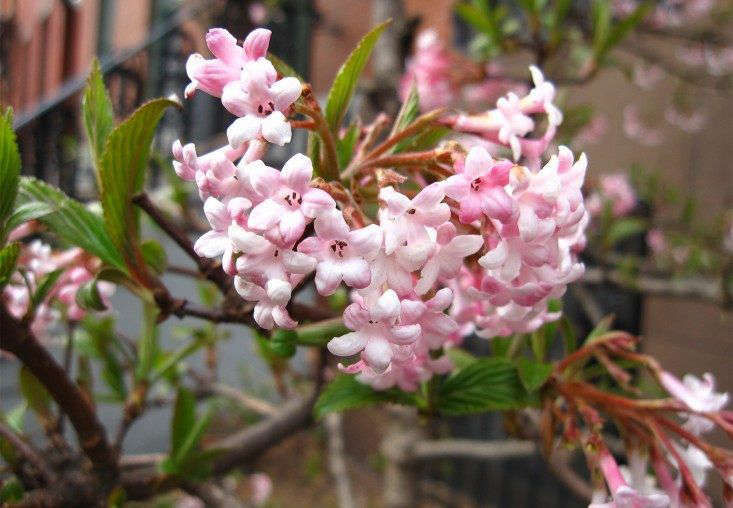

The really effective gardens (meaning, they give you a boost when you most need it), tiny or large, supply botanical interest for every part of the season.
The really effective gardens (meaning, they give you a boost when you most need it), tiny or large, supply botanical interest for every part of the season.
Photography by Marie Viljoen.
Photography by Marie Viljoen.
Cultivars of the Asian witch hazels Hamamelis mollis and H. japonica, and North American H. vernalis unfurl their bright streamers in the cold of the new year.
Cultivars of the Asian witch hazels Hamamelis mollis and H. japonica, and North American H. vernalis unfurl their bright streamers in the cold of the new year.
Witch Hazels
Witch Hazels
Different cultivars provide a color palette from acid yellow (H. mollis ‘Pallida’) to warm red (H. x intermedia ‘Diane’); ‘Jelena’ has an orange center with bright yellow tassels, and ‘James Wells’ holds onto its neatly rolled brown leaves that lie like secrets beneath its pale yellow flowers.
Different cultivars provide a color palette from acid yellow (H. mollis ‘Pallida’) to warm red (H. x intermedia ‘Diane’); ‘Jelena’ has an orange center with bright yellow tassels, and ‘James Wells’ holds onto its neatly rolled brown leaves that lie like secrets beneath its pale yellow flowers.
For best bloom witch hazels should be planted in full sun in USDA zones 5-9.
For best bloom witch hazels should be planted in full sun in USDA zones 5-9.
Pussy Willow
Pussy Willow
The cashmere-soft kitten-paw flowers of North American pussy willow (Salix discolor) are one of the earliest of botanical spring messengers.
The cashmere-soft kitten-paw flowers of North American pussy willow (Salix discolor) are one of the earliest of botanical spring messengers.
Some of the most surprising flowers to open in early spring are the Camellia japonica cultivars. Top-dress camellias every fall with shredded bark or compost, and fertilize in spring, making sure that they do not dry out when in bud.
Some of the most surprising flowers to open in early spring are the Camellia japonica cultivars. Top-dress camellias every fall with shredded bark or compost, and fertilize in spring, making sure that they do not dry out when in bud.
Camellias
Camellias
The tongue-twisting Viburnum x bodnantense ‘Dawn’ is a shrub that stops passersby in their tracks. As the buds open and the air warms, their fruity scent increases, inviting a closer look.
The tongue-twisting Viburnum x bodnantense ‘Dawn’ is a shrub that stops passersby in their tracks. As the buds open and the air warms, their fruity scent increases, inviting a closer look.
Dawn Viburnum
Dawn Viburnum
Cornelian Cherry
Cornelian Cherry
Not a cherry at all, Cornus mas belongs to the dogwood family and is native from southern Europe, into the Middle East.
Not a cherry at all, Cornus mas belongs to the dogwood family and is native from southern Europe, into the Middle East.
Edgeworthia
Edgeworthia
Edgeworthia papyrifera (commonly called paper bush, or yellow daphne, for scent reasons) is still a novelty plant to many gardeners.
Edgeworthia papyrifera (commonly called paper bush, or yellow daphne, for scent reasons) is still a novelty plant to many gardeners.
In the earliest of springs and later winters, clusters of pale yellow flowers open from downy white buds. Edgeworthia’s natural habitat is east Asian wood- and streamsides, so this is a shrub that likes long drinks.
In the earliest of springs and later winters, clusters of pale yellow flowers open from downy white buds. Edgeworthia’s natural habitat is east Asian wood- and streamsides, so this is a shrub that likes long drinks.
Winter daphne (Daphne odora) is a thrilling source of cold-weather perfume: its intense, lemony fragrance spreads right through a garden.
Winter daphne (Daphne odora) is a thrilling source of cold-weather perfume: its intense, lemony fragrance spreads right through a garden.
Daphne
Daphne
While the fat-flowered prima donnas of the magnolia world reach their peak weeks later, the star magnolia, Magnolia stellata, upstages them by opening early, emitting a subtle fragrance.
While the fat-flowered prima donnas of the magnolia world reach their peak weeks later, the star magnolia, Magnolia stellata, upstages them by opening early, emitting a subtle fragrance.
Star Magnolia
Star Magnolia
While most magnolias prefer well drained, slightly acidic soil, star magnolia is adaptable and will tolerate alkaline and moist soils.
While most magnolias prefer well drained, slightly acidic soil, star magnolia is adaptable and will tolerate alkaline and moist soils.